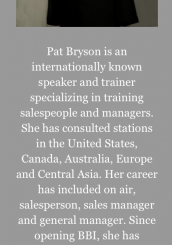
Why Failure Can Lead To Success
Content from BPRRadio, like any business, needs people who are willing to take well-calculated risks to continually improve their product offering. Building that new morning show, implementing a format that no one has done before, redefining the way you undertake tactics etc.But sometimes, things don’t always go according to the script.
However, there are many valuable lessons to be learned from failure which can lead to success in the future. Failure is a necessary part of innovation.
Failure can often be a stepping stone to success for several reasons:Learning and Growth. Failure provides valuable lessons and insights. When we encounter setbacks or make mistakes, we have an opportunity to analyse what went wrong, understand our shortcomings and learn from them. This process of self-reflection and learning helps us gain experience and develop new strategies for future endeavours, increasing our chances of success.Resilience and Perseverance. Failure tests our resilience and determination; it presents us with challenges and obstacles that require us to push through adversity. When we face failure head-on and refuse to give up, we build resilience and develop a stronger mindset. This resilience can be a powerful tool in achieving long-term success because it helps us bounce back from setbacks and keep going despite obstacles.Innovation and Creativity. Failure often forces us to think outside the box and explore new approaches. When our initial plans or methods don’t work, we are prompted to seek alternative solutions. This need for innovation and creativity can lead to breakthroughs and new ideas that we may not have considered otherwise. Failure encourages us to experiment, take risks, and explore uncharted territories, which can ultimately lead to success.Motivation and Drive. Failure can fuel our motivation and drive to succeed. Experiencing setbacks can ignite a strong desire to prove ourselves, overcome the odds and achieve our goals. Failures can serve as powerful reminders of our aspirations, pushing us to work harder, improve our skills, and persist until we achieve success.
Perspective and Adaptability. Failure provides us with a fresh perspective and an opportunity to reassess our goals and strategies. It prompts us to evaluate our strengths and weaknesses, identify areas for improvement and adapt our approach accordingly. By being open to change and willing to adjust our course, we increase our chances of finding success in new and unexpected ways.Now let’s make one very important point. As Amazon founder Jeff Bezos said, “There are two kinds of failure…and only one is something to be proud of”“I always point out that there are two different kinds of failure,” Bezos said. “There’s experimental failure — that’s the kind of failure you should be happy with.” These are the big, bold bets that either “move the needle” or involve a public face plant”.But Bezos also notes there’s “operational failure,” and entrepreneurs should attach no mystique at all to these sorts of misfires. “We’ve built hundreds of fulfilment centres at Amazon over the years, and we know how to do that. If we build a new fulfilment centre and it’s a disaster, that’s just bad execution. That’s not good failure,” Bezos explains. Extending your existing business is known territory and, if executed properly, should not involve much in the way of risk. If you screw up something you should already know how to do, that’s nothing to celebrate.”Thomas Edison may hold the record for the most failed attempts before reaching success on a single project, having failed several thousand times before inventing a functional light bulb. His response has become famous to entrepreneurs: “I have not failed. I’ve just found 10,000 ways that won’t work.”And finally, in the words of Bill Gates: “It’s fine to celebrate success but it is more important to heed the lessons of failure.”By David Kidd, BPR […]





